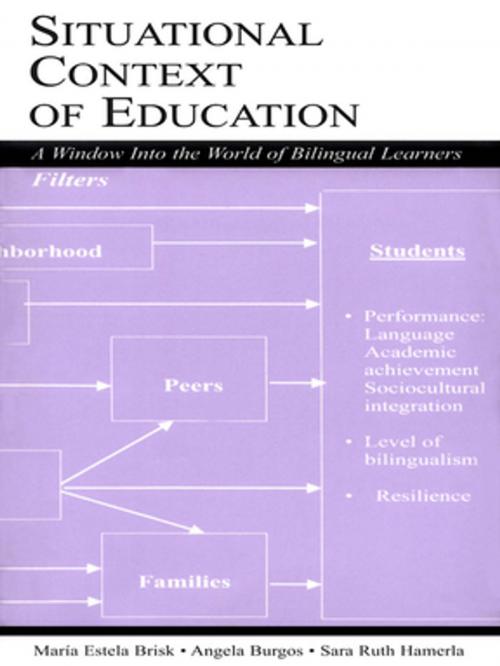Situational Context of Education
A Window Into the World of Bilingual Learners
Nonfiction, Reference & Language, Education & Teaching, Educational Theory, Bilingual Education, Teaching| Author: | Mar¡a Estela Brisk, Angela Burgos, Sara Ruth Hamerla | ISBN: | 9781135644574 |
| Publisher: | Taylor and Francis | Publication: | May 20, 2004 |
| Imprint: | Routledge | Language: | English |
| Author: | Mar¡a Estela Brisk, Angela Burgos, Sara Ruth Hamerla |
| ISBN: | 9781135644574 |
| Publisher: | Taylor and Francis |
| Publication: | May 20, 2004 |
| Imprint: | Routledge |
| Language: | English |
This book gives educators important answers to the urgent question of how teachers and schools can facilitate language minority and immigrant students' progress in school. It offers an innovative and powerful method teachers and students can use to study the situational context of education, providing both the theoretical background and the practical tools to implement this approach.
The situational context of education includes linguistic, economic, social, cultural, and political factors, as well as conditions, such as students' personal characteristics, family support, and quality of instruction. All of these factors influence the lives of students and their academic performance and contribute in many ways, some subtle and indirect, to making the educational experience more or less difficult for different students.
The premise of the book is that objective study of the situational context of education by both students and teachers is beneficial because it leads to a more realistic view of how to facilitate students' progress in school. Designed as a text for graduate courses for preservice and in-service teachers working with students in bilingual, ESL, mainstream, and special education classrooms, the goal is to engage readers in learning not only from the literature but also from studying the situational contexts of their own students. The focus here is on the factors that affect language minority and immigrant students in the United States, but the framework is equally powerful for work with student populations in other social contexts.
*The Introduction includes an overview of the theory behind the study of the situational context of education and the implementation of this approach; describes the context of the pilot lessons included in the book; and explains how to use the lessons detailed in later chapters.
*Chapters 2-6 focus on different factors in the situational context of education: linguistic, economic, social, cultural, and political. A three-part structure is used: "Classroom Implementation" (a rich description of one lesson in a real classroom); "Context Variables" (a theoretical explanation of the specific factor the chapter addresses, providing the research basis for the sample lesson objectives ); "Doing Analysis of the Context" (several sample lessons for implementation). The lessons are addressed to the teacher, with detailed ideas on how to carry out the lesson and evaluate the students' understanding of the situational context.
*Five Appendices provide helpful resources for the implementation of the lessons: an Annotated bibliography of relevant K-12 children's literature; Instructional Approaches; Scoring Rubrics for Content Objectives; Guidelines for a Contrastive Study of Situational Context; and Lesson Template.
The lessons have been thoroughly field-tested with students and teachers. Because these lessons work on multiple levels, Situational Context of Education: A Window Into the World of Bilingual Learners benefits students from first grade through preservice and in-service teachers in university courses. Teachers get to know their students and their predicaments within the social context of the United States, and at the same time, the lesson activities have a great impact on the students in their classes. All are helped to achieve academically while gaining awareness of situational factors affecting their lives.
This book gives educators important answers to the urgent question of how teachers and schools can facilitate language minority and immigrant students' progress in school. It offers an innovative and powerful method teachers and students can use to study the situational context of education, providing both the theoretical background and the practical tools to implement this approach.
The situational context of education includes linguistic, economic, social, cultural, and political factors, as well as conditions, such as students' personal characteristics, family support, and quality of instruction. All of these factors influence the lives of students and their academic performance and contribute in many ways, some subtle and indirect, to making the educational experience more or less difficult for different students.
The premise of the book is that objective study of the situational context of education by both students and teachers is beneficial because it leads to a more realistic view of how to facilitate students' progress in school. Designed as a text for graduate courses for preservice and in-service teachers working with students in bilingual, ESL, mainstream, and special education classrooms, the goal is to engage readers in learning not only from the literature but also from studying the situational contexts of their own students. The focus here is on the factors that affect language minority and immigrant students in the United States, but the framework is equally powerful for work with student populations in other social contexts.
*The Introduction includes an overview of the theory behind the study of the situational context of education and the implementation of this approach; describes the context of the pilot lessons included in the book; and explains how to use the lessons detailed in later chapters.
*Chapters 2-6 focus on different factors in the situational context of education: linguistic, economic, social, cultural, and political. A three-part structure is used: "Classroom Implementation" (a rich description of one lesson in a real classroom); "Context Variables" (a theoretical explanation of the specific factor the chapter addresses, providing the research basis for the sample lesson objectives ); "Doing Analysis of the Context" (several sample lessons for implementation). The lessons are addressed to the teacher, with detailed ideas on how to carry out the lesson and evaluate the students' understanding of the situational context.
*Five Appendices provide helpful resources for the implementation of the lessons: an Annotated bibliography of relevant K-12 children's literature; Instructional Approaches; Scoring Rubrics for Content Objectives; Guidelines for a Contrastive Study of Situational Context; and Lesson Template.
The lessons have been thoroughly field-tested with students and teachers. Because these lessons work on multiple levels, Situational Context of Education: A Window Into the World of Bilingual Learners benefits students from first grade through preservice and in-service teachers in university courses. Teachers get to know their students and their predicaments within the social context of the United States, and at the same time, the lesson activities have a great impact on the students in their classes. All are helped to achieve academically while gaining awareness of situational factors affecting their lives.















